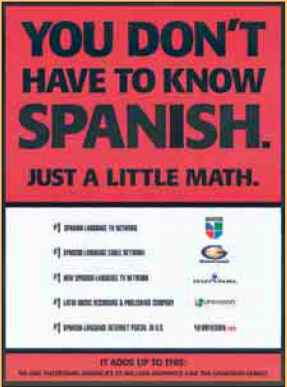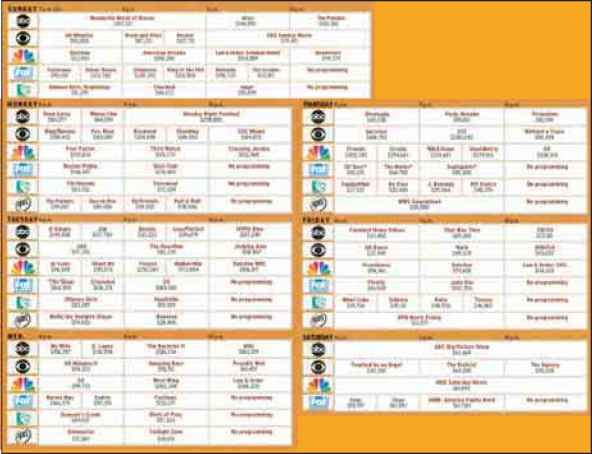Spanish Speaking TV Stations Go Mano a Mano
The television industry has grown accustomed to fierce battles among the major networks for viewers, as ABC,CBS,NBC,and Fox have always gone head-to-head with one another. However, the fiercest battle being waged right now in the television industry is the struggle between the two largest Spanish-language television networks in the United States—Univision and Telemundo. The two companies are fighting to lure the eyeballs of the 35 million Hispanics in the United States, a market segment that is projected to grow by 15 percent by 2010. According to Nielsen Media Research estimates, there are nearly 9 million Hispanic-American television households in the United States and about one-third of them speak no English at home. Language usage has an important impact on their choice of TV programs, and a substantial share of viewing in these homes goes to Spanish-language television. Moreover, Hispanics tend to be younger, have larger families, and watch nearly 10 hours of TV a day, which is about 2 hours more than non-Hispanics watch.
Univision, which is based in Los Angeles, dominates the Hispanic market in the United States, as it commands over 70 percent of the audience watching Spanish-language TV. The company has 26 television stations and 32 broadcast affiliates; it also owns Galavision, which is available to 25 million cable subscribers; 50 percent of Disa Records, the world's second-largest Spanish-language record label; and Univision Online, which recently set up a marketing pact with America Online. In 2002 Univision launched the bilingual network TeleFutura, which has captured 8 percent of the estimated 3 million prime-time Hispanic TV viewers, and purchased Hispanic Broadcasting, the largest chain of Hispanic radio operations in the United States, with 55 stations. Programming on Univision's core network is full of novelas or soap operas produced by Mexico's Grupo Televisa; the shows are very popular among Hispanics of Mexican descent, who make up nearly two-thirds of the Latino population in the United States. Its programming also includes soccer matches, variety, news, and music shows.
Univision's big rival is Telemundo, based in Hialeah, Florida, which was purchased by General Electric Co.'s NBC network in late 2001. Telemundo has seen its ratings rise for the past three years with programming that includes novelas in prime time and sports, movies, and comedies on the weekend. In 2002 Telemundo entered into a three-year deal to broadcast
NBA and WNBA games in Spanish. Since it is part of NBC, Telemundo can promote its shows heavily on the network, which will also give it the Spanish-TV rights to other programs such as the Billboard Latin Music Awards,the Olympics,and Miss Universe contests.
A major part of the war between Univision and Telemundo is being waged in battles for programming. Two months after NBC announced its Telemundo deal, Univision rewrote deals with its two largest suppliers, Televisa and Venezuela's Venesision, so that it would have exclusive rights to their programming. Univision also signed an agreement with the Brazilian producers of Telemundo's hottest show, Betty La Fea ("Betty the Ugly"), which gives it the rights to the show's sequel. Univision is also counting on Telefutura to help it reach a different audience—the 60 percent of Hispanics in the United States who are tuned to English-language channels. To pull in this audience, Telefutura will air sports and movies popular with men against the prime-time soaps on Univision and Telemundo. Univision is even advertising the new network in

English, placing radio spots on general-market stations to promote Telefutura among bilingual Hispan-ics in New York and Los Angeles.
Univision and Telemundo are fighting over the fastest-growing media market in the United States: Ad spending on Hispanic television is growing nearly 10 percent a year, while advertising revenues in mainstream network television have shown little or no increases. A major reason for this growth is that major advertisers such as Sears, Kmart, Miller Brewing Co., Ford, McDonald's, and many others recognize the importance of the Hispanic market and are developing commercials specifically for this market. These companies also recognize that Spanish-language TV networks are the best means of reaching this fast-growing market with their television spots. Univision already has surpassed the major networks in several big-city markets, as its stations in Los Angeles, New York, Miami, Houston, and Dallas had higher prime-time ratings in the coveted l8-to-34 age category than did their ABC, CBS, NBC,and Fox counterparts during a recent ratings period.
While Univision and Telemundo are likely to continue their battle for Hispanic TV viewers, it appears there is plenty of room for both networks to continue to grow. However, they are likely to face competition from other media companies, such as ESPN. Owned by Disney, ESPN is launching a 24-hour, Spanish-language sports cable network in late 2003. The ESPN Deportes' programming will include Major League and Latin American baseball, NBA games, volleyball, soccer, and a Spanish version of ESPN's signature show, Sportscenter.
Sources: Barry Jackson,"ESPN to Launch Spanish-Language Network," The Miami Herald, Sept. 25, 2002, p. 1; Ronald Grover and Aixa M. Pascual, "Mana a Mano in Hispanic TV," BusinessWeek, Sept. 9, 2002, p. 122; Eduardo Porter,"Univision Seeks a Bigger Pie for Spanish TV," The Wall Street Journal, Jan. 14,2002, pp.Bl, 3.
Figure 11-2 What TV shows cost: estimated price of a 30-second spot on the major networks: Fall 2002
Figure 11-2 What TV shows cost: estimated price of a 30-second spot on the major networks: Fall 2002

regional basis, so an advertiser's message can be aired in certain sections of the country with one media purchase.
Spot and Local Advertising Spot advertising refers to commercials shown on local TV stations, with time negotiated and purchased directly from the individual stations. All nonnetwork advertising done by a national advertiser is known as national spot advertising; airtime sold to local firms such as retailers, restaurants, banks, and auto dealers is known as local advertising. Local advertisers want media whose coverage is limited to the geographic markets in which they do business. This may be difficult to accomplish with TV, but many local businesses are large enough to make efficient use of TV advertising.
Spot advertising offers the national advertiser flexibility in adjusting to local market conditions. The advertiser can concentrate commercials in areas where market potential is greatest or where additional support is needed. This appeals to advertisers with uneven distribution or limited advertising budgets, as well as those interested in test marketing or introducing a product in limited market areas. National advertisers often use spot television advertising through local retailers or dealers as part of their cooperative advertising programs and to provide local dealer support.
A major problem for national advertisers is that spot advertising can be more difficult to acquire, since the time must be purchased from a number of local stations. Moreover, there are more variations in the pricing policies and discount structure of individual stations than of the networks. However, this problem has been reduced somewhat by the use of station reps, individuals who act as sales representatives for a number of local stations in dealings with national advertisers.
Spot ads are subject to more commercial clutter, since local stations can sell time on network-originated shows only during station breaks between programs, except when network advertisers have not purchased all the available time. Viewership generally declines during station breaks, as people may leave the room, zap to another channel, attend to other tasks, or stop watching TV.
While spot advertising is mostly confined to station breaks between programs on network-originated shows, local stations sell time on their own programs, which consist of news, movies, syndicated shows, or locally originated programs. Most cities have independent stations that spot advertisers use. Local advertisers find the independent stations attractive because they generally have lower rates than the major network affiliates.
The decision facing most national advertisers is how to combine network and spot advertising to make effective use of their TV advertising budget. Another factor that makes spot advertising attractive to national advertisers is the growth in syndication.
Syndication Advertisers may also reach TV viewers by advertising on syndicated programs, shows that are sold or distributed on a station-by-station, market-by-market basis. A syndicator seeks to sell its program to one station in every market. There are several types of syndicated programming. Off-network syndication refers to reruns of network shows that are bought by individual stations. Shows that are popular in off-network syndication include Seinfeld, Everybody Loves Raymond, and Friends. The FCC prime-time access rule forbids large-market network affiliates from carrying these shows from 7 to 8 p.m., but independent stations are not affected by this restriction. A show must have a minimum number of episodes before it is eligible for syndication, and there are limits on network involvement in the financing or production of syndicated shows.
Off-network syndication shows are very important to local stations because they provide quality programming with an established audience. The syndication market is also very important to the studios that produce programs and sell them to the networks. Most prime-time network shows initially lose money for the studios, since the licensing fee paid by the networks does not cover production costs. Over four years (the time it takes to produce the 88 episodes needed to break into syndication), half-hour situation comedies often run up a deficit of millions, and losses on a one-hour drama show are even higher. However, the producers recoup their money when they sell the show to syndication.
Figure 11-3 Top 10 regularly scheduled syndicated programs 2001-2002 Season
First-run syndication refers to shows produced specifically for the syndication market. The first-run syndication market is made up of a variety of shows, including some that did not make it as network shows. Examples of popular first-run syndication shows include talk shows such as Live with Regis & Kelly and The Jerry Springer Show, entertainment shows such as Inside Edition and Entertainment Tonight, and dramas such as VIP.
Advertiser-supported or barter syndication is the practice of selling shows to stations in return for a portion of the commercial time in the show, rather than (or in addition to) cash. The commercial time from all stations carrying the show is packaged into national units and sold to national advertisers. The station sells the remaining time to local and spot advertisers. Both off-network and first-run syndicated programs are offered through barter syndication. Usually, more than half of the advertising time is presold, and the remainder is available for sale by the local advertiser. Barter syndication allows national advertisers to participate in the syndication market with the convenience of a network-type media buy, while local stations get free programming and can sell the remainder of the time to local or spot advertisers. Recently, the straight barter deal has given way to more barter/cash arrangements, where the station pays for a program at a reduced rate and accepts a number of preplaced bartered ads. Top-rated barter syndicated programs include Wheel of Fortune, Jeopardy, and The Oprah Winfrey Show.
Syndication now accounts for more than a third of the national broadcast audience and has become a very big business, generating ad revenue comparable to any of the big-three networks. Syndicated shows have become more popular than network shows in certain dayparts, such as daytime, early prime time, and late fringe. In some markets, syndicated shows like Wheel of Fortune draw a larger audience than the network news.
Many national advertisers use syndicated shows to broaden their reach, save money, and target certain audiences. For example, off-network syndication shows such as Friends, Seinfeld, and X-Files are popular with advertisers because they reach the highly sought after, and often difficult to reach, young-adult audience (age 18 to 34) and are about 15 to 20 percent lower on a cost-per-thousand basis than network shows.21 Figure 11-3 shows the top 10 syndicated programs in 2002.
Syndication has certain disadvantages, such as more commercial time and thus more clutter. The audience for syndicated shows is often older and more rural, and syndicators do not supply as much research information as the networks do. Syndication also creates more problems for media buyers, since a syndicated show may not be seen in a particular market or may be aired during an undesirable time period. Thus, media buyers have to look at each market and check airtimes and other factors to put together a syndication schedule.
Continue reading here: The Osbournes Gives New Meaning to Reality TV
Was this article helpful?
Readers' Questions
-
Henry1 month ago
- Reply
-
Kifle3 months ago
- Reply
-
Leon6 months ago
- Reply
-
Kristian12 months ago
- Reply
-
Nea Peltola12 months ago
- Reply
-
anna1 year ago
- Reply
-
daniela1 year ago
- Reply
-
Charles1 year ago
- Reply
-
ornella1 year ago
- Reply
-
antonella1 year ago
- Reply

